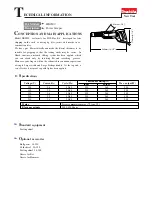
HLS | Drill Jig Operating Instructions
HLS Features
Environmentally sustainable, durable, and
fl
exible. At the
pinnacle of Australian lighting innovation: The HLS delivers
the best lm/$ for outdoor access ways.
The system features are:
•
Australian design and manufacture
•
High energy ef
fi
ciency (>100 lm/W)
•
Glare-free access lighting
•
Suitable for any metallic surface
• Extreme
durability
- IK10 vandal resistance
- marine compatible (316 stainless steel)
- up to IP67
•
Flexible lighting concept
- install in curved or
fl
at surfaces
-
fi
ts >ø25mm handrail
- suitable for wall thicknesses >1.5mm
- available in 3 beam types
- any dimming protocol
•
Emergency lighting compatible
•
Stand alone solar PV solutions
•
Proprietary installation system
- easy and ef
fi
cient
- consistent, high quality installations
Before you start
Before you start, take some time to get an overview of how
the HLS system is installed. Your process should involve the
following steps:
1. Check the diameter and wall thickness of the rail or
substrate to which the pucks will be installed.
2. Check the puck type supplied, and con
fi
rm that they
are suitable for the job. Determine if you need to drill the
counterbore (for heavy wall pucks) or not.
3. Mark out the LED positions
4. Practice: steps 5-13 (set depth, drill, tap) on a spare
piece of rail (if available).
5. Clamp drill jig to the rail and align to the
fi
rst mark
6. Attach the drilling tool
7. Drill the 15mm hole, reverse drill
8. Adjust the depth setting nut
9. Drill the counterbore if required. Back the drill out by
engaging the reverse gear.
10. Remove drilling tool, clean out internal and external
mating surfaces and insert tapping tool
11. Tap hole, then remove tool
12. Inspect, and deburr the hole
13. Test the thread and counterbore depth by screwing a
puck into the new hole
14. Drill/tap/inspect/deburr/test all remaining holes
Tips
1. Keep it Clean: No component of the drill jig should be
placed where there is a risk of contamination with foreign
particles (eg: dirt, sand etc). Replace the components in
the storage case supplied when not in use.
2. Practice First: Drill a practice hole on a spare piece of
pipe before beginning work on the job. This allows you to
test your tools and process. Take this opportunity to set
the depth without risking damage to the project.
Identify the puck type
Determining the type of thread will dictate how you drill and
tap the holes.
Take some time to check that the minipuck supplied is
suitable for the job at hand:
1. What diameter is the rail? Does the puck supplied
fi
t the
curvature of this rail?
2. What wall thickness is the rail, and is the puck suitable
for this thickness? For wall thickness 1.5 - 2.5mm, you
must use the thin wall puck. For wall thicknesses over
2.5mm, you can use either thin wall or heavy wall pucks.
Now, identify the puck type based on the following:
HW - Heavy Wall (>2.5mm)
!
Drill: with counterbore
External thread is NOT cut all the way through to the front
face of the puck. An uncut shoulder is visible adjacent to the
front face of the puck.
TW - Thin Wall (>1.5mm)
!
Drill: NO counterbore
External thread is cut all the way through to the front face of
the puck.
HLS
Drill Jig Operating Instructions
Curved Face
Curved Face
Flat Face
Flat Face






















